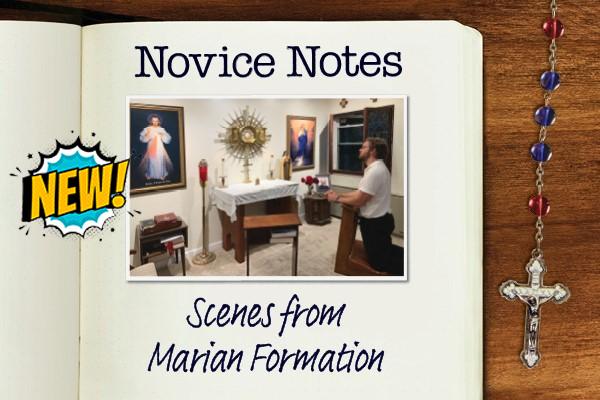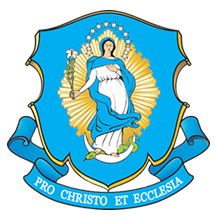
Being in this spacious, bright, beautiful building, rich in art and history, the place from which our country is led, is certainly not to be forgotten.
Welcome to Part 28 of a series on the formation journey of Josh, a first-year novice at the Marian House of Studies in Washington, D.C.
Start at the beginning here.
It was a quiet, cool evening as I sat outside on our religious house’s patio in Washington, D.C., with some Maronite guests, chatting with them and Marian seminarian Br. Ryan. We were eating some salad and pizza.
One of the Lebanese Maronite seminarians, a young man named Jacob, asked me, “So, is this a normal Saturday for you?”
I paused for a second, then exclaimed, “No!”
“No?” he repeated, slightly taken aback at the strength of my response.
“We visited the White House today!” I told him.
No ordinary event
Visiting the White House is no ordinary novitiate event. Michael, one of my fellow novices, used to work as an intern in the White House, and he has a friend in his senator’s office who helped arrange for our visit.
For a while, it looked like we would not receive permission because two in our group were priests from other countries. They had been denied permission in the past, and had to request permission through their embassies, a process we didn’t know about when we submitted our request to visit.
Despite the confusion, in the end, we were all approved. We were a small group of five Marians; one diocesan priest; Michael’s mother, Delphia; and her friend Heidi.
“The Secret Service can suspend your rights of due process under law for up to 72 hours under certain conditions,” Michael warned. “So don’t mess with them!”
Tough and alert
Perhaps two or three hundred people had permission to visit that morning, so they were lined up near the White House Visitor Center. A group of Boy Scouts in uniform stood in line, right in front of us.
The men and women of the Secret Service were friendly, but they also came across as tough and alert.
Michael had worked at the White House a few years prior to the 9/11 terrorist attacks on the World Trade Center. He mentioned that the fence surrounding the gardens looked much higher now than when he had worked there. There were also sharp points on top of the bars, which he hadn’t seen before.
A Secret Service agent happened to be walking by just as Michael shared this, and he paused to say, “The fence is five feet higher now.”
A bomb-sniffing dog came up to me and checked me out as I passed.
“Hey, boy,” I said as he gave my hand a sniff.
Father David laughed. “It’s cross-eyed! It’s the first time I have ever seen a cross-eyed dog!”
It did look a little deranged.
As we walked by the garden, two Secret Service women in black and a man in a suit with an ear piece scanned the area, checking the bushes to make sure the area was clear. It was fun to see them doing their job.
East Wing
We went through three checkpoints on our way in, and we passed a large statue of General Sherman on horseback.
“That road was not closed down when I worked here before,” Michael told me, pointing out a quiet, empty road behind us. “They’ve broadened their perimeter since 9/11.”
Then we reached the East Wing. It was a simple white structure surrounded by lush, green foliage. When we stepped inside, we found ourselves surrounded by portraits of presidents, their wives, and visiting dignitaries.
I was delighted by a photo of a jovial, grandfatherly President Reagan beaming as he danced with the beautiful, young Princess Diana, who was also smiling. Reagan’s appearance and manner made me think of my own grandfather. To me, it seemed an adorable moment.
We took photos everywhere we went, which the Secret Service permitted, as long as it wasn’t video or flash photography.
I noticed when I took one of my first photos that my camera was still set on flash, and I hurriedly switched off the setting.
Portraits
There were beautiful paintings of First Lady Hilary Clinton, Michelle Obama, and Laura Bush. President Obama looked very noble in his painting, and President Reagan looked happy. The art and pictures honoring the Kennedy family were particularly striking.
Jackie Kennedy was frequently visible in paintings and photos, beautiful and regal.
There was a painting of President John Kennedy with his head and shoulders bowed. The painting made him appear to bear the weight of the world on his shoulders. He had to live, make mistakes, and learn from them in the midst of appallingly grave danger of nuclear war, with the world depending on him making the right decisions.
We walked through the Green Room, which used to be Thomas Jefferson’s dining room, and Michael noticed how we could easily see the Jefferson Memorial from the window of the dining room where Jefferson used to eat.
Michael told me that a president once sat here with many Nobel Prize winners, and told them that there was never so much intelligence in one place before — except when Thomas Jefferson dined there alone!
The gardens inside the White House grounds were beautiful, with lush green hedges, lawns and rows of roses. We gazed on them through the windows, as we walked by.
In the State Dining Room, we talked for a couple minutes with a guard. He mentioned that this dining room was used about three times a week. It could host 130 guests. All the rooms that we were passing through were used regularly; this was not a museum.
View from within
One moment that jumped out to me was taking a picture of the Washington Mall, the fountain, and the main entrance to the White House from inside the building. Normally, everyone sees exactly the same sight from outside the White House, peaking through the bars of the fence at the entrance, but I was peeking “back” at the people outside through one of those windows, from within.
As we went outside, our walk-through complete, Michael pointed out to me the three tinted windows on the upper level where the Bidens live. You couldn’t see in, but they could see out. We were right below the President’s room.
It was brought to my attention after the visit that, very likely, there had been a sniper watching us at that point.
The scores of visitors ambled slowly down the path away from the White House, and I noticed a man in plain clothes step out of the midst of us, over a chain barrier. He walked up to a Secret Service agent in black and had a few words with her. He ran his fingers through the back of his blue coat, revealing a radio and what looked like a firearm.
He was some kind of undercover officer, keeping an eye on the crowd from within.
Novices David, Michael, and I got our pictures taken on the steps of the White House entrance, and then all of our group got a picture. We also posed for pictures under the White House Seal.
Then we were on our way.
A thrill
“Oh, wow!” the Maronite Jacob exclaimed, laughing. “No, I guess that wouldn’t be a normal day! Well, what was your favorite thing about visiting the White House?”
I paused, thinking over all that I had just experienced.
When witnessing something extraordinary, such a moment jumps out. Being in this spacious, bright, beautiful building, rich in art and history, the place from which our country is led, is certainly not to be forgotten.
I answered, “It’s not any particular thing. It’s a thrill I can’t put into words.”
Previous entry
{shopmercy-ad}
















